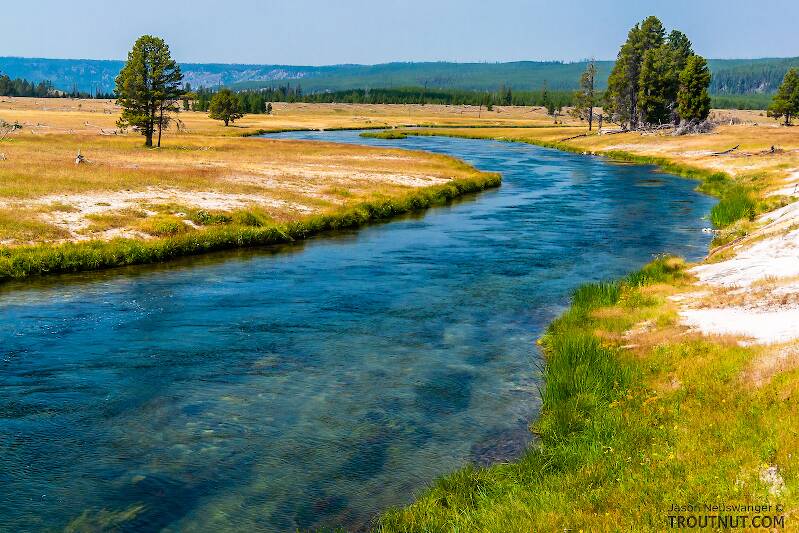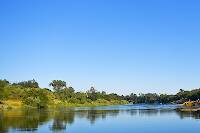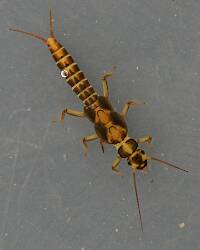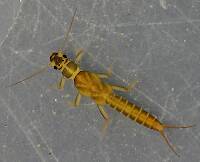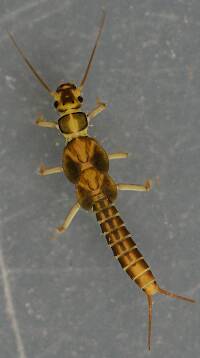
Salmonflies
Pteronarcys californica
The giant Salmonflies of the Western mountains are legendary for their proclivity to elicit consistent dry-fly action and ferocious strikes.
Featured on the forum

Some characteristics from the microscope images for the tentative species id: The postero-lateral projections are found only on segment 9, not segment 8. Based on the key in Jacobus et al. (2014), it appears to key to Neoleptophlebia adoptiva or Neoleptophlebia heteronea, same as this specimen with pretty different abdominal markings. However, distinguishing between those calls for comparing the lengths of the second and third segment of the labial palp, and this one (like the other one) only seems to have two segments. So I'm stuck on them both. It's likely that the fact that they're immature nymphs stymies identification in some important way.

Troutnut is a project started in 2003 by salmonid ecologist Jason "Troutnut" Neuswanger to help anglers and
fly tyers unabashedly embrace the entomological side of the sport. Learn more about Troutnut or
support the project for an enhanced experience here.
Willmilne on May 18, 2009May 18th, 2009, 12:49 pm EDT
Hi
I have recently uncovered a locale with recorded collection records for both these species and am keen to collect and photograph specimens.Nymphs and adults . I have light traps/emergence traps for the adults but...
Does anyone have suggested substrate/stream location preferences for the nymphs? For P.vittigera all I can find is a preference for clay banks and T.primus nada.
Any help would be deeply appreciated.
Will
I have recently uncovered a locale with recorded collection records for both these species and am keen to collect and photograph specimens.Nymphs and adults . I have light traps/emergence traps for the adults but...
Does anyone have suggested substrate/stream location preferences for the nymphs? For P.vittigera all I can find is a preference for clay banks and T.primus nada.
Any help would be deeply appreciated.
Will
GONZO on May 18, 2009May 18th, 2009, 5:44 pm EDT
Will,
Both species apparently burrow in clay banks. Berner (1988) offers some information. He quotes Scott et al. (1959) describing the substrate preferred by Tortopus in the Savannah River: Berner notes that the burrows enter the bank at right angles forming U-shaped tubes with parallel arms. In the description of Pentagenia, he mentions this:
Both species apparently burrow in clay banks. Berner (1988) offers some information. He quotes Scott et al. (1959) describing the substrate preferred by Tortopus in the Savannah River:
"The clay substrate inhabited by Tortopus is always firm, nearly always vertical, and usually exposed to swift water."
McCafferty (1975) collected nymphs in hard clay banks approximitely three feet below the water surface in the Wabash River in Indiana. He found the clay banks to be honeycombed by Pentagenia nymphs in the same manner that the banks of the Savannah River are honeycombed by Tortopus.
Konchu on May 19, 2009May 19th, 2009, 6:07 am EDT
If you're not afraid of hard work and possibility of drowning, go for it! It takes some hard digging...
Willmilne on May 19, 2009May 19th, 2009, 11:52 am EDT
Thank you for the info. that helps a great deal as the locale offers some accessible spots that would match those descriptions.
Konchu- the work is not a problem - drowning might put a serious damper on my summer plans:)))
Will
Konchu- the work is not a problem - drowning might put a serious damper on my summer plans:)))
Will
Willmilne on May 19, 2009May 19th, 2009, 2:55 pm EDT
Thanks for the mention of Berner and McCafferty - I found some info on the FAMU site that will be a great help.
Will
Will
Quick Reply
Related Discussions
Topic
Replies
Last Reply
1
Nov 3, 2015
by TimCat
by TimCat

